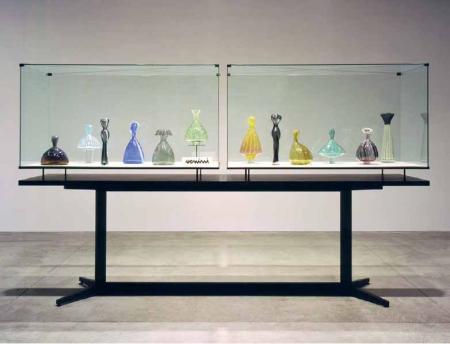Josiah McElheny
dal 17/4/2002 al 16/6/2002
Segnalato da
17/4/2002
Josiah McElheny
Centro Galego de Arte Contemporanea CGAC, Santiago de Compostela
CGAC is pleased to present Josiah McElheny first exhibition in Spain.

Curator: Michael Tarantino
Presentation
Michael TARANTINO
An Historical Anecdote About Fashion
Text published in the catalogue A Historical Anecdote About Fashion, Henry Art Gallery, University of Washington, 1999
-Much of the ancient glass found today is recovered from tombs that protected it from the nearly
inevitable breakage aboveground. The ancients buried domestic objects with their dead for use in the
afterlife, and as a reminder of their former life.
-We know that Julius Alexander was married, as his wife left the hairpin he made for her in his tomb.
We know that he practiced his art in Gaul but was a citizen of Rome, possibly born in Africa, Egypt
or Carthage.
-We believe he blew the pieces found in the tomb but since they are without signature we can only
be sure that he made the hairpin. Earlier historians attribute certain bottles found in Rome to his
workshop. The ‘stele’ is in the Musee des Beaux Arts in Lyon. In his tomb was common domestic
glass of the third century, six bottles, four plates, two cups, one hairpin.-
Josiah McElheny, text from -The Only Known Grave of a Glassblower- (1994)
The work of Josiah McElheny exists in the space between the factual, the historic, the imagined,
the fantastic. Often accompanied by a description which places the work in another dimension,
that of narration or historical perspective, the actual pieces suggest another, possible world.....a
world of the present, a world of the imagination.
McElheny’s show at the Centro Gallego de Arte Contemporanea will be the first major exhibition
of his work organized by a European museum. It will feature a number of important recent
works, including Untitled (White) (2000), From an Historical Anecdote About Fashion (2000) and
Verzelini’s Acts of Faith (1996) as well as two new pieces commissioned by CGAC. Together, they
illustrate the various aspects of McElheny’s practice, which can seem both seductive and puzzling:
the objects which are evidence of the artist’s skill in glass-blowing, learned through years of
apprenticeship; the tension between reconstructing history and imagining history; the relationship
between the fabricated and the appropriated object; the original and the copy; the tension between
architecture and the objects and spaces contained within; the notion of display and how it effects
our viewing of an object; the relationship between text and object; etc.
Together, all of these elements provide a rich experience for the viewer: he/she must take an
active position in entering McElheny’s world. They must filter and edit the information provided
for them in order to achieve a coherent whole. Which is not to say that the picture they form is
going to be definitive.
In fact, one could divide McElheny’s work into four related themes: Modern Objects, Historical
Objects, Painting and Mirrors. Each work in the exhibition may be seen in the light of one of these
themes. For example, Untitled (White) and From an Historical Anecdote About Fashion represent
modern objects. Impurities and Travels in the Roman Empire represent historical objects.
Verzelini’s Acts of Faith and other works refer to historical painting and the Borges works refer
to the mirror. The artist refers to these categories as the history of objects past and present
as well as the way in which they are reflected.
In From an Historical Anecdote About Fashion, we read the following text:
In the 1952 Venice Biennal, Venini, the famous glass design company, entered a display of vases
designed not by the factory’s artists and architects, but by the glassblowers. The unusual shapes and
cloth-like patterning were based on the haute couture fashions which the owner’s French wife wore
when she visited the factory. Ginette Gagnous Venini was intimately involved in running the company
with her husband Paolo Venini, and could often be seen by the male workers in the furnace room as
she ascended and descended the stairs of the office.
McElheny goes on to describe the eventual influence of Christian Dior designs on Ginette,
which were then translated into the glass designs in the Venini factory. But what remains with the
spectator, as we look at the multicoloured glass models of figurines and vessels that are
arranged in a vitrine, is the figure of Ginette, walking down the factory hallway, going up and
down the stairs of the office, eyed by the workers below. It is a seductive image, one that
resonates with fact and fiction. And in combination with the visual materials that accompany it, it
is typical of McElheny’s work: between history and imagination, between the street, the factory
and the theatre.
Josiah McElheny has had solo exhibitions and installations at the Henry Art Gallery, Seattle;
Isabella Stewart Gardner Museum, Boston; Art Institute of Chicago; Brent Sikkema Gallery, New
York and Donald Young Gallery, Chicago. His work has been included in such group exhibitions as
Site Santa Fe (Santa Fe, New Mexico, 2000), Whitney Biennal (Whitney Museum of American Art,
New York) and Young Americans, Part II (Saatchi Gallery, London). He received his B.A. degree
from the Rhode Island School of Design and studied with master glassblowers Jan-Erik Ritzman,
Lino Tagliapietre and Ronald Wilkinson. McElheny lives and works in New York.
The exhibition will be accompanied by a full-colour catalogue which will include essays by
Michael Tarantino and Louise Neri.
Michael Tarantino, curator of the exhibition
Image: Josiah McElheny: From an Historical Anecdote About Fashion, 2000
Blown-glass object, display case, five framed digital prints; dimesions of display case: 72h. x 120 inches, digital prints: 18h. x 25 1/2 inches
Photo credit: Tom Van Eynde. Courtesy Donald Young Gallery
Hall, Double Space, Ground Floor
CGAC
CENTRO GALEGO DE ARTE CONTEMPORÃNEA
Rúa Ramón del Valle Inclán s/n
15704 Santiago de Compostela
Tel. 981 546 619
Fax 981 546 625



